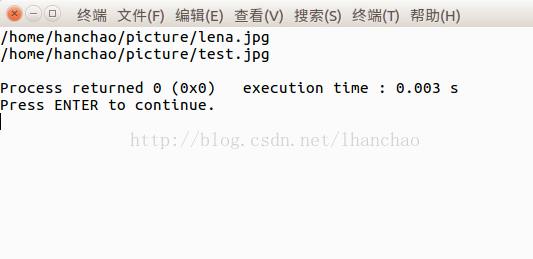一、Linux下遍历方法
方法非常简单,这里不多说了,可以直接看代码。
#include <dirent.h>//遍历系统指定目录下文件要包含的头文件
#include <iostream>
using namespace std;
int main()
{
DIR* dir = opendir("/home/hanchao/picture");//打开指定目录
dirent* p = NULL;//定义遍历指针
while((p = readdir(dir)) != NULL)//开始逐个遍历
{
//这里需要注意,linux平台下一个目录中有"."和".."隐藏文件,需要过滤掉
if(p->d_name[0] != '.')//d_name是一个char数组,存放当前遍历到的文件名
{
string name = "/home/hanchao/picture/" + string(p->d_name);
cout<<name<<endl;
}
}
closedir(dir);//关闭指定目录
}
这里需要注意,由于p->d_name存放的是文件名,所以也可以通过像strstr(p->d_name,".jpg")等来判断,遍历指定类型的文件。
文件夹中:

运行结果:

二、Windows下遍历指定目录下所有文件
同样,直接看代码吧。
#include <io.h>//所需头文件
#include <iostream>
#include <string>
using namespace std;
void getAllFileNames(const string& folder_path)
{
_finddata_t file;
long flag;
string filename = folder_path + "\\*.jpg";//遍历制定文件夹内的jpg文件
if ((flag = _findfirst(filename.c_str(), &file)) == -1)//目录内找不到文件
{
cout << "There is no such type file" << endl;
}
else
{
//通过前面的_findfirst找到第一个文件
string name = folder_path + "\\" + file.name;//file.name存放的是遍历得到的文件名
cout << name << endl;
//依次寻找以后的文件
while (_findnext(flag, &file) == 0)
{
string name = string(folder_path + "\\" + string(file.name));
cout << name << endl;
}
}
_findclose(flag);
}
int main()
{
getAllFileNames("test");//test是制定的目录
}
这里在Windows下寻找所有文件也会有“.”和".."文件,如果要遍历目录下的所有文件,则需要过滤这两个,过滤方法同Linux方法。
test原目录下文件:

运行结果:


